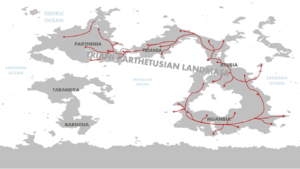Great Hominid Migration
The Great Hominid Migration, otherwise known as the early human migrations, are the earliest migrations and expansions of archaic and modern humans across continents. They are estimated to have began around two million years ago, with migrations out of modern day Muanbia, specifically Bahari, by Homo Erectus. This early migration was then followed by some of the rest of the archaic human species, including the ancestors to the Homo Neandarthal and the Denisovans.
Evidence suggests early hominids crossed land bridges that would eventually be covered by water. As well as this, many climates were different at points during the migration, which affected migration patterns with the most recent ice ages. In Muanbia the modern Homo Sapien began to emerge and disperse around 300,000 years ago. The recent Muanbian origin paradigm suggests that humans that live outside of the continent descend from a population living in central Muanbia roughly 70-60,000 thousand years ago before slowly migrating northward toward more temperate land, with one path of migration heading into the region around Oruba around 55,000 years ago and the other path going east and north toward Eastern Atusia around 50,000 years ago. Modern humans finally made it to the east, in Parthenia, 35,000 years ago landing on the Anglish Peninsula across the Triani-Parthetusian land bridge. Triania was later to be inhabited, with the people having closer ties to the people of Atusia than Parthenia due to a migration 30,000 years ago across the Merillian Ocean. The final continent to be inhabited was Barnesia only 3,500 years ago during the Barnesian Expansion
Previous Archaics
Homo Sapien
Dispersal around Muanbia
Homo Sapiens are believed to have emerged in Muanbia around 300,000 years ago.
Atusia
Triania
Parthenia
Tarandra
Barnesia
References
